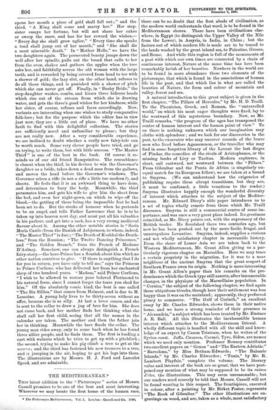THE MEDITERRANEAN.* Tuffs latest addition to the " Picturesque "
series of Messrs. Cassell promises to be one of the best and most interesting. Wherever we may locate the first home of the human race,
• The Picturesque Mediterranean. Vol. I. London : Cassell said Co. 1E90
there can be no doubt that the first abode of civilisation, as the modern world understands that word, is to be found in the Mediterranean shores. There have been civilisations else- where, in Egypt (to distinguish the Upper Valley of the Nile from the Lower), in Assyria, in India, in China ; but the factors out of which modern life is made are to be traced to the lands washed by the great inland sea, to Palestine, Greece, and Rome. And while this region is full of the monuments of a past with which our own times are connected by a chain of continuous interest, Nature at the same time has here been remarkably lavish of her beauties. Nowhere in the world are to be found in more abundance these two elements of the picturesque, that which is found in the associations of human life in the past, and that which lies in what are called the beauties of Nature, the form and colour of mountain and valley, forest and sea.
A natural introduction to this great subject is given in the first chapter, " The Pillars of Hercules," by Mr. H. D. Train. To the Phoenician, Greek, and Roman, the " untravelled world," on which his most eager thoughts were fixed, lay to the westward of this mysterious boundary. Now, as Mr. Trail remarks, "the progress of the ages has transposed the centre of human interest and the human point of view." To us there is nothing unknown which our imagination may clothe with splendour ; and we look for our discoveries in the past, to the excavator who may uncover records of the brave men who lived before Agamemnon, or the traveller who may find in some forgotten library of the Levant the lost dirges of Pindar, the comedies of the rivals of Aristophanes, or the missing books of Livy or Tacitus. Modern explorers, in short, sail eastward, not westward between the " Pillars." From Gibraltar and the Punta de Africa (a singularly un- equal match for its European fellow), we are taken at a bound to Smyrna. (We can understand how the exigencies of publishing require these abrupt transitions, but they are, it must be confessed, a little vexatious to the reader.) Smyrna illustrates happily enough the wonderful diversity of interest which attaches to the subject of the Mediter- ranean. Mr. Edward Dicey's able paper introduces us to a set of topics wholly remote from those which Mr. Traill discusses. Smyrna is still a commercial centre of some im- portance, and was once a very great place indeed. Its greatness coincided, as Mr. Dicey points out, with the supremacy of the British trader. He flourished there two centuries ago, but now he has been pushed out by the more facile, frugal, and unscrupulous Levantine. Smyrna, indeed, supplies a curious and not wholly satisfactory chapter in mercantile history. From the shore of Lesser Asia we are taken back to the Western Mediterranean, Mr. Grant Allen giving us a par- ticularly vigorous chapter on Marseilles. Here we may trace a certain propriety in the migration, for it was to a near neighbour of the ancient Smyrna that the great seaport of Southern France owes its origin. Nothing is more interesting in Mr. Grant Allen's paper than his remarks on the pre- dominance which the Greek type still asserts, after innumerable changes, in the physique of the Marseillaise population. In " Corsica," the subject of the following chapter, we find again these ubiquitous Greeks, though here their settlement was leas happy than it was on the mainland ; apparently, they preferred piracy to commerce. " The Gulf of Corinth," an excellent essay by Mr. Charles Edwardes, shows them in their native home, and we have a strong reminder of their presence in " Alexandria," a subject which has been treated by Mr. Eustace A. R. Ball. All this illustrates the inexhaustible human interest which attaches to the Mediterranean littoral. A wholly different topic is handled with all the skill and know- ledge of an expert by Canon Tristram, when he writes of the Syrian coast. Jaffa, Cresarea, Carmel, Tyre, Sidon, are names which we need only mention. Professor Bonney contributes two excellent papers on " Genoa " and The Eastern Adriatic." " Barcelona," by Miss Betham-Edwards; " The Balearic Islands," by Mr. Charles Edwardes ; "Tunis," by Mr. R. Lambert Playfair," complete the volume. The literary value and interest of the book are so great, that we have post- poned any mention of what may be supposed to be its raison cl-etre, the illustrations. This may seem unreasonable ; but our readers need scarcely be told that Messrs. Cassell will not be found wanting in this respect. The frontispiece, executed in colour, after a painting by Mr. Birket Foster, represents "The Rock of Gibraltar." The other illustrations are en- gravings on wood, and are, taken as a whole, most satisfactory
examples of the art. There are some the delicacy and beauty of which it would be difficult to excel. Mr. E. T. Compton contributes the illustrations for " Corsica," " Barcelona," and "The Balearic Islands ;" Mr. John Fulleylove, those for " Marseilles " and " Genoa ; " while " Smyrna " and " The Gult of Corinth" are treated by Mr. John AlacWhirter ; " Tunis " and " Alexandria," by Mr. W. H. J. Boot ; " The Pillars of Hercules," by Mr. John O'Connor ; "The Syrian Coast," by Mr. Henry A. Harper ; and " The Eastern Adriatic," by Mr. Charles W. Wyllie.























































 Previous page
Previous page